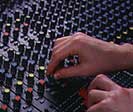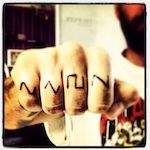| Author
|
Levels...
|
Freeflow
IsraTrance Full Member

Started Topics :
60
Posts :
3709
Posted : Jan 27, 2011 16:49
|
Quote:
|
On 2011-01-27 01:03, woodster77 wrote:
ita a logarithmic scale
low frequenceies take more db to become audible
and higher freqs take less
trust me google it
there is a standard scale to fit with the human ear
then research transient behaviour or the sounds you want to work with( i use a spectrograph)
then add the two together in your own way and
this will get you working towards a clearer
mind set of mixing
ps try not to use compression too much rather focus on layering sounds to get the feel
remember if you need to boost or cut a freq by + or - 3db its not the right sound to begin with
|
|
Yes i know about Fletcher-Munson curves aswell  so i trust you. so i trust you.
Transients can be a bitch, compressing the peaks to RMS will often make the sound dull, so its a balance, to achieve loudness with clarity which i think equals dynamics. I think its needed to compress if peak and RMS values are too far a part, as you will lose too much loudness, sure dynamics are important but you can stretch it pretty much before it becomes dull.
And layering is nice, but it wont fix the things i am talking about, and that is great difference in peak to RMS value. I use layering to create interesting sounds, or to make them fuller. Its just the same as adding another oscillator. For example if you have a saw-wave bass and want it to sound fuller you and a sinewave to get the lowend fuller.
And i would not agree that if a sound needs to be cut by +/- 3dB its the wrong sound to begin with, No, not at all. In-fact its most of the time necessary to cut sounds, and sometimes boost. But you can also use filter on a synthesizer to find a smoother curve, but most of the time if i find LP suits better for a full sound then just cut some lowend with EQ to take away rumble. But cutting somewhere will boost somewhere else, so its sometimes a job of adjusting the whole spectrum and sometimes multiple instance of EQs
But each to their own and as long as you get your desired results its fine
|

|
|
Freeflow
IsraTrance Full Member

Started Topics :
60
Posts :
3709
Posted : Jan 27, 2011 17:36
|
|
woodster77
IsraTrance Full Member

Started Topics :
119
Posts :
1733
Posted : Jan 27, 2011 17:37
|
good point...should have put in that its not USUALLY the right sound to work with
but by layering sounds you can apply different envelopes and have control over the timeline of the sound rather than treating it as another oscillator that is matched with the same settings
heres another good post on refernce levels and headroom....a bit of a side step for the thread but relevant none the less
http://www.digido.com/level-practices-part-2-includes-the-k-system.html |

|
|
woodster77
IsraTrance Full Member

Started Topics :
119
Posts :
1733
Posted : Jan 27, 2011 17:38
|
will do later on bud cheers |

|
|
Freeflow
IsraTrance Full Member

Started Topics :
60
Posts :
3709
Posted : Jan 27, 2011 17:39
|
Quote:
|
On 2011-01-27 17:37, woodster77 wrote:
good point...should have put in that its not USUALLY the right sound to work with
but by layering sounds you can apply different envelopes and have control over the timeline of the sound rather than treating it as another oscillator that is matched with the same settings
|
|
true, that is one point a forgot about. That is infact really cool to have layerd sounds fade in and out of eachother to create motion
|

|
|
woodster77
IsraTrance Full Member

Started Topics :
119
Posts :
1733
Posted : Jan 27, 2011 17:43
|
i try to work like that most of the time as you can really sculpt the sound you want rather than get close then force it with effects, which i find in turn affects the rest of the mix and starts a kind of knock on effect
and makes mixing harder work therfore slowing down the process |

|
|
aciduss
IsraTrance Full Member

Started Topics :
112
Posts :
1490
Posted : Jan 27, 2011 17:52
|
I know Tron personally, when i had the chance to learn from him, basslines were mostly Cronox2 and some careful EQ with Sonnox units.
I remember him HighPassin' bass at 36hz or even higher and kick around 30hz, he talked to me about how it would sound big enough in PA and low end could be enhaced in mastering... i was stunned by how much of the low end he removed and still managed to sound good and phat, he also carefully removed resonant frequencies from between 100 - 400 hz mainly using the sweep and notch technique to reduce harmonics in the muddy area, same technique applied to kick, he also boosted fundamental a little. |

|
|
Freeflow
IsraTrance Full Member

Started Topics :
60
Posts :
3709
Posted : Jan 27, 2011 18:06
|
Quote:
|
On 2011-01-27 17:52, aciduss wrote:
I know Tron personally, when i had the chance to learn from him, basslines were mostly Cronox2 and some careful EQ with Sonnox units.
I remember him HighPassin' bass at 36hz or even higher and kick around 30hz, he talked to me about how it would sound big enough in PA and low end could be enhaced in mastering... i was stunned by how much of the low end he removed and still managed to sound good and phat, he also carefully removed resonant frequencies from between 100 - 400 hz mainly using the sweep and notch technique to reduce harmonics in the muddy area, same technique applied to kick, he also boosted fundamental a little.
|
|
Nice pointers  Thanks for sharing Thanks for sharing
|

|
|
Nectarios
Martian Arts

Started Topics :
187
Posts :
5292
Posted : Jan 27, 2011 18:23
|
Quote:
|
On 2011-01-27 16:14, Nomad Moon wrote:
Quote:
|
On 2011-01-27 15:28, disco hooligans wrote:
The kick and bass of that Tron clip sound great on my HR824s. Its a good example of good sounding kick and bassline.
|
|
I think u got me wrong. I wish i could understand how he does it, i can't get that very defined sub control, i tweak and tweak and it sounds all wrong with too much subs, if i cut them it sounds thin, and problem is i don't have a clue how u do it, and this happens when i listen to your's or Wizack's tracks also, you guys basses are just perfect. I know it's a learning process but in Tron's track the kick seems to have less subs then the bass i think, do u guys agree?
|
|
Yes, the kick does have less sub than the bass.
As far as sub goes and what I have taught my self from endless tweaking/EQing/compressing...I use the following practise on both kick and bass.
There are basically 3 different ways of controlling the sub, which I use in combination. Each way reduces the actual or apparent sub presence in either the kick or bass, but they actually sound different.
1) The obvious way, hi-pass filter. By hi-passing the bassline at say 38hz you effectively remove the really deep stuff that you don't need. Notice that as the sub goes deep, you don't actually hear the sub, you mostly feel it. The thing to consider here is the slope at which you will set the hi-pass filter. The higher the slope the more apparent the ringing/phase distortion from the inherent properties of filters. Getting a good EQ to high pass your bassline helps.
2) Compression.
I set my kick and bass compressor with an approx 20msec attack setting, meaning that when the incoming signal goes over the threshold and triggers the compressor, it allows the transient to go through (20mseconds of it) and then slams down on the "body" of the kick/bassline note. Which means the gain reduction is on the body/tail of the kick/bassline where the sub is most apparent, thus reducing it.
3) (kick/bassline) note length.
The longer the note, sustain, tail, the more the sub level. Simple example of understanding this. Make a bassline patch, quantize the notes to 1/16th and set on the bassline synth's amp envelope (ADSR) an attack of 0ms (or right before clicking), sustain at 0ms, release at 0ms (or right before clicking) and set the decay at max. Play the sequencer and start lowering the decay, you'll hear the sub starting to go out as the note gets shorter. It kinda sounds like you're hi-passing the bassline, yet the hi-pass filter frequency does not change. The sub gets less apparent as the note gets tighter.
So, a combination of the above will get you the desired kind of bassline, short tight sub, longer sustain with not a lot of sub going on (it does work in tunes where you might want the kick to do the sub work), but from hours upon hours of anal listening, I have figured out these 3 ways that actually sound different, when it comes to controlling the sub of both the kick and bassline.
Prerequisite is to find a good bassline synth/drum machine to create my bassline sound, careful kick tuning and bassline filter envelope shaping, EQing out resonances and "boxiness" of the 300-500Hz range and then getting down to sorting the subs out.
Its a procedure that I discovered 6 months ago and have followed meticulously to make the third album tunes.
Peace out.
       
http://soundcloud.com/martianarts |

|
|
Nomad Moon
IsraTrance Full Member

Started Topics :
134
Posts :
1516
Posted : Jan 27, 2011 19:00
|
Quote:
|
On 2011-01-27 18:23, disco hooligans wrote:
Quote:
|
On 2011-01-27 16:14, Nomad Moon wrote:
Quote:
|
On 2011-01-27 15:28, disco hooligans wrote:
The kick and bass of that Tron clip sound great on my HR824s. Its a good example of good sounding kick and bassline.
|
|
I think u got me wrong. I wish i could understand how he does it, i can't get that very defined sub control, i tweak and tweak and it sounds all wrong with too much subs, if i cut them it sounds thin, and problem is i don't have a clue how u do it, and this happens when i listen to your's or Wizack's tracks also, you guys basses are just perfect. I know it's a learning process but in Tron's track the kick seems to have less subs then the bass i think, do u guys agree?
|
|
Yes, the kick does have less sub than the bass.
As far as sub goes and what I have taught my self from endless tweaking/EQing/compressing...I use the following practise on both kick and bass.
There are basically 3 different ways of controlling the sub, which I use in combination. Each way reduces the actual or apparent sub presence in either the kick or bass, but they actually sound different.
1) The obvious way, hi-pass filter. By hi-passing the bassline at say 38hz you effectively remove the really deep stuff that you don't need. Notice that as the sub goes deep, you don't actually hear the sub, you mostly feel it. The thing to consider here is the slope at which you will set the hi-pass filter. The higher the slope the more apparent the ringing/phase distortion from the inherent properties of filters. Getting a good EQ to high pass your bassline helps.
2) Compression.
I set my kick and bass compressor with an approx 20msec attack setting, meaning that when the incoming signal goes over the threshold and triggers the compressor, it allows the transient to go through (20mseconds of it) and then slams down on the "body" of the kick/bassline note. Which means the gain reduction is on the body/tail of the kick/bassline where the sub is most apparent, thus reducing it.
3) (kick/bassline) note length.
The longer the note, sustain, tail, the more the sub level. Simple example of understanding this. Make a bassline patch, quantize the notes to 1/16th and set on the bassline synth's amp envelope (ADSR) an attack of 0ms (or right before clicking), sustain at 0ms, release at 0ms (or right before clicking) and set the decay at max. Play the sequencer and start lowering the decay, you'll hear the sub starting to go out as the note gets shorter. It kinda sounds like you're hi-passing the bassline, yet the hi-pass filter frequency does not change. The sub gets less apparent as the note gets tighter.
So, a combination of the above will get you the desired kind of bassline, short tight sub, longer sustain with not a lot of sub going on (it does work in tunes where you might want the kick to do the sub work), but from hours upon hours of anal listening, I have figured out these 3 ways that actually sound different, when it comes to controlling the sub of both the kick and bassline.
Prerequisite is to find a good bassline synth/drum machine to create my bassline sound, careful kick tuning and bassline filter envelope shaping, EQing out resonances and "boxiness" of the 300-500Hz range and then getting down to sorting the subs out.
Its a procedure that I discovered 6 months ago and have followed meticulously to make the third album tunes.
Peace out.
|
|
I must say that right now i'm really humbled, this is the best kick & bass "tutorial" i've read in some years of isratrance, thank u very much Mr.DH this should be sticked with the name "Mr.Disco Hooligans SUB Control thread" and it should be closed 
BE Very Well  |

|
|
Nectarios
Martian Arts

Started Topics :
187
Posts :
5292
Posted : Jan 27, 2011 19:10
|
Hope it helps you out somewhat mate, although the most important thing I forgot to mention, is that you need speakers that go low enough and (some) acoustic treatment, in order to get into the nitty gritty of the bottom end.
Meaning that, when I mixed our first two albums, I EQed out resonances that occurred in certain notes of the kick/bassline patch. So there was me notching out ringing that I thought was bad, BUT! it was only bad in my old, untreated room. And to make things worse, having monitors that go low (or sub) amplified the bad artifacts of my old room.
So you really need to know you are actually notching out the bad ringing and not destroying the definition of your bottom end, which I unfortunately, did...
...oh well, live and learn...
Peace out.
       
http://soundcloud.com/martianarts |

|
|
aciduss
IsraTrance Full Member

Started Topics :
112
Posts :
1490
Posted : Jan 27, 2011 19:15
|
Nice advice DH, appreciated.
What about synths, how much do you HP them? I usually 180hz for low synths and 220hz for higher. |

|
|
Nectarios
Martian Arts

Started Topics :
187
Posts :
5292
Posted : Jan 27, 2011 19:19
|
Quote:
|
On 2011-01-27 19:15, aciduss wrote:
Nice advice DH, appreciated.
What about synths, how much do you HP them? I usually 180hz for low synths and 220hz for higher.
|
|
There abouts as well, although I might dip the low mids as well, especially on some resonant leads with low notes/cut-off frequency tweaks. It depends on the kind off lead, if I got lots of overdrive/distortion in it...etc.
Peace out.
       
http://soundcloud.com/martianarts |

|
|
PoM
IsraTrance Full Member

Started Topics :
162
Posts :
8087
Posted : Jan 27, 2011 19:20
|
Nectarios was talking about the envelop of the synth,when tweaking it i always think to futur processing ,eq ,compression , to get a source that will need less of it .
on some bassline it can go from somthing sounding like shit to a sound that will need not much eq just with carefful tweaking of the envelop and notes lenght . it s the same for kicks,amp envelop is so powerfull to get a source that will need less eq and/or compression .
just saying this cause its amaze me how it s possible to make a sound better with carefful tweaking of synths . |

|
|
Freeflow
IsraTrance Full Member

Started Topics :
60
Posts :
3709
Posted : Jan 27, 2011 19:44
|
Quote:
|
On 2011-01-27 19:20, PoM wrote:
Nectarios was talking about the envelop of the synth,when tweaking it i always think to futur processing ,eq ,compression , to get a source that will need less of it .
on some bassline it can go from somthing sounding like shit to a sound that will need not much eq just with carefful tweaking of the envelop and notes lenght . it s the same for kicks,amp envelop is so powerfull to get a source that will need less eq and/or compression .
|
|
thats true, i have noticed this also, getting correct lengths will make it sound very clean and groovy. Its a little job but well worth it. And doing it as well as possible in the beginning saves a lot of time
|

|
|
|